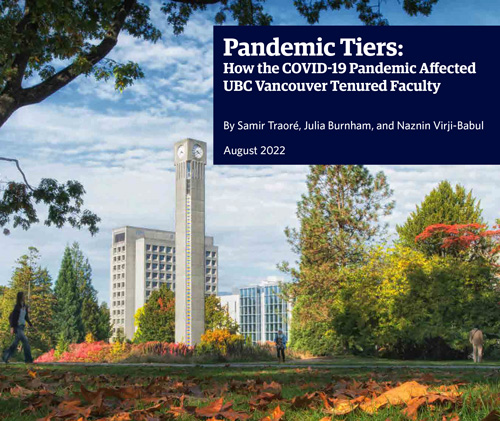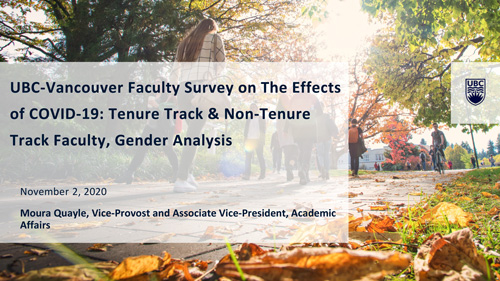
Attracting and retaining a diverse faculty is a key component of UBC’s commitment to excellence in teaching, learning and research.
The Provost works closely with the Deans, the Associate Vice-President, Equity and Inclusion, and the UBC Executive on a range of equity and diversity initiatives. To learn more about UBC’s equity and diversity initiatives, reporting on progress, and the Equity Enhancement Fund, please see the resources below and visit the Equity and Inclusion Office’s website.
UBC’s Strategic initiatives
Strategic Equity and Anti-Racism Framework
The UBC Equity & Inclusion Office has launched a new Strategic Equity and Anti-Racism (StEAR) Framework to guide the implementation of UBC’s various equity and anti-racism plans and recommendations. The StEAR framework reflects the need for individual and systemic interventions across four nested organizational domains for change – structural, curricular, compositional, and interactional.
Please visit the Equity Office website to learn more about the StEAR Framework.
Indigenous Strategic Plan
UBC’s 2020 Indigenous Strategic Plan outlines eight goals and 43 actions the university will collectively take to advance its vision of UBC as a leading university globally in the implementation of Indigenous peoples’ human rights.
Visit the ISP website to read about the plan and the implementation.
Inclusion Action Plan
UBC’s Inclusion Action Plan presents an opportunity for UBC to continue to develop its potential as a groundbreaking 21st century institution, including its leadership in creating global influence through its equitable, diverse, and inclusive campuses. Read about the plan.
Anti-Racism and Inclusive Excellence Task Force Report
The Anti-Racism and Inclusive Excellence Task Force convened for an intense period of work in April 2021. Its six committees representing Work and Study constituencies and Equity Deserving Racialized Groups has put forward 54 recommendations in its final report, which is now available.
The Task Force was created as part of the response to UBC’s commitment to build a more inclusive university community. The work of the Task Force is supported by the Office of the President and the Co-Executive Leads for Anti-Racism.
The Task Force’s report was published in January 2022, with 54 recommendations. View the recommendations.
Faculty Strategy
UBC Faculties are committed to advancing inclusivity, and in ensuing that diversity principles are the foundation of the academic fabric at UBC.
Please visit the Faculty websites to read about their commitments and actions.
- Peter A. Allard School of Law
- Faculty of Applied Science
- Faculty of Arts
- Faculty of Dentistry
- Faculty of Education
- Faculty of Graduate and Postdoctoral Studies
- Faculty of Forestry
- Faculty of Land and Food Systems
- Faculty of Medicine
- Faculty of Pharmaceutical Sciences
- UBC Sauder School of Business
- Faculty of Science
Reports
UBC Vancouver faculty survey on the effects of COVID-19
Faculty Recruitment + Retention: Employment Equity
UBC's Commitment to Equity, Diversity and Inclusion within the CRC Program
UBC has a robust strategy for raising awareness of our commitment to and the benefits of equity, diversity and inclusion within the Canada Research Chair Program (CRCP) and our broader research enterprise. Learn more
Dual career programs
UBC supports the needs of dual career couples for tenure-track and tenured faculty and some administrative positions. Learn more
Gender pay equity initiative (2010-2012)
Find information below on the Gender pay equity initiative at UBC.
- Report of the Pay Equity (DATA) Working Group (2010)
- Report of the Structural Measures and Resolution Tactics (SMART) Working Group (January 2011)
- Report of the Gender Pay Equity Recommendation Committee: UBCV (July 2012)
- Report of the Gender Pay Equity Recommendation Committee: UBCO (October 2012)
- Gender Pay Equity – Joint Message from Provosts and Faculty Association (January 21, 2012)
- UBC's report to the BC Human Rights Tribunal on the Gender Pay Gap in Professorial Salaries at UBC (2018)
Resources for Faculty
Faculty mentoring programs
Mentoring programs help our faculty members meet their full potential and can be a rewarding experience for mentors. The Provost’s Office supports mentoring through the Academic Leadership Development Program. Many of our faculties and departments also have mentoring programs for their faculty members. Learn more
Salary increases
As part of the Gender Pay Equity Initiative, UBC is working with its Faculties to foster best practice in annual faculty merit and performance salary adjustment (PSA) awards. Here we provide a guide for designing and ensuring effective and transparent processes for these awards. View the guide
Maternity, parental, or adoptive leaves
Several UBC Faculties have articulated maternity/parental/adoptive leaves policies and momentum following leaves in detail. Below is one example from the Faculty of Science. View the policy
Contact
Dr. Janice Stewart, Deputy Provost
janice.stewart@ubc.ca
604-827-5368

